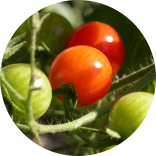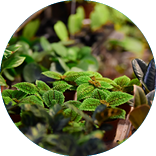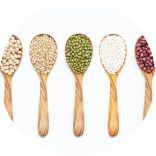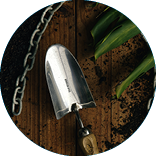Anzuchtanleitung Gemüsesamen-Set
Aubergine
Eggplant
Anzucht
Damit Sie noch im selben Jahr ernten können, sollten Sie die Pflanzen ab Februar im Haus vorziehen. Setzen Sie die Samen circa einen Zentimeter tief in feuchtes Kokossubstrat oder BIO-Gemüseerde. Decken Sie das Anzuchtgefäß mit Klarsichtfolie ab, die Sie mit Löchern versehen. So ist das Substrat belüftet und vor Austrocknung geschützt. Alle zwei bis drei Tage sollten Sie die Folie für 2 Stunden entfernen. Das beugt einer Schimmelbildung auf dem Anzuchtsubstrat vor. Stellen Sie das Anzuchtgefäß an einen hellen und warmen Ort mit 20 bis 25° Celsius und halten Sie das Anzuchtsubstrat feucht, aber nicht nass. Wenn sich nach zwei bis vier Wochen die ersten Keimlinge zeigen, kann die Abdeckung des Anzuchtgefäßes entfernt werden. Sobald sie erste Laubblätter ausgebildet haben, sollten die Sämlinge pikiert und einzeln in Töpfe umgepflanzt werden. Wenn es im Freien wärmer wird, können Sie die Töpfe tagsüber ab und an nach draußen stellen, sodass die Pflänzchen sich an den Aufenthalt im Freien gewöhnen. Nach den Eisheiligen können Sie die Pflanzen im Abstand von je ungefähr 60 Zentimetern ins Beet setzen oder in größeren 10-Liter-Töpfen halten.
Standort
Wählen Sie einen sonnigen, windgeschützten Standort, im Idealfall an einer südlichen Hauswand, die zusätzliche Wärme abgeben kann. Der Boden sollte locker und nährstoffreich sein, weshalb es sich empfiehlt, vor der Pflanzung Kompost in ihn einzuarbeiten.
Pflege
Geben Sie den Pflanzen von Beginn an eine Rankhilfe mit in den Topf oder das Beet. Achten Sie außerdem auf eine regelmäßige Wasserzufuhr, vermeiden Sie jedoch unbedingt Staunässe. Darüber hinaus können Sie den Pflanzen mehrmals mit einer kleinen Zufuhr von BIO-Gemüsedünger helfen.
Im Winter
Wegen ihrer Frostempfindlichkeit werden Auberginen meist einjährig kultiviert und jedes Jahr neu ausgesät.
Growing
In order to be able to harvest in the same year, you should grow the plants indoors from February onwards. Plant
the seeds about one centimetre deep in moist coco substrate or organic vegetable soil. Cover the growing
container with transparent film and make holes in it. This keeps the substrate ventilated and protects it from
drying out. Every two to three days you should remove the foil for 2 hours. This prevents mould from forming on
the growing medium. Place the propagator in a bright and warm place with 20 to 25° Celsius and keep the
substrate moist but not wet. When the first seedlings appear after two to four weeks, the cover of the
propagator can be removed. As soon as they have formed the first leaves, the seedlings should be pricked out and
transplanted individually into pots. When it gets warmer outdoors, you can move the pots outside from time to
time during the day so that the seedlings get used to being outdoors. After the ice-harvests, you can transplant
the plants into the bed about 60 centimetres apart or keep them in larger 10-litre pots.
Location
Choose a sunny, wind-protected location, ideally on a south-facing house wall that can provide additional
warmth. The soil should be loose and rich in nutrients, so it is advisable to work compost into it before
planting.
Care
Give the plants a climbing aid in the pot or bed right from the start. Also ensure a regular supply of water,
but avoid waterlogging at all costs. In addition, you can help the plants several times with a small supply of
organic vegetable fertiliser.
In winter
Because of their sensitivity to frost, aubergines are usually cultivated as annuals and resown every year.
Blumenkohl (Schneeball)
Cauliflower
Anzucht
Sie können die Pflanzen ab Mitte Februar im Haus vorziehen. Setzen Sie die Samen dazu ungefähr einen halben Zentimeter tief in Kokosfasersubstrat oder BIO-Gemüseerde. Gießen Sie die Samen vorsichtig an und stellen sie bei 15 bis 20° Celsius an einen hellen Ort. Halten Sie die Aussaat anschließend feucht, verhindern Sie dabei aber Staunässe. So zeigen sich nach ein bis zwei Wochen die ersten Keimlinge. Sofern sie nicht schon in einzelnen Anzuchttöpfen angebaut wurden, können die Setzlinge vereinzelt werden, sobald sie erste kräftige Blätter ausgebildet haben. Ab April können die Pflanzen dann im Abstand von jeweils einem halben Meter ins Freie gepflanzt werden.
Standort
Pflanzen Sie Blumenkohl an einem sonnigen bis halbschattigen Standort. Der Boden sollte dabei tiefgründig sowie nährstoffreich sein, weshalb man ihn vor der Pflanzung auflockern und dabei Kompost einarbeiten sollte. Außerdem wäre ein hohes Wasserspeichervermögen vorzuziehen.
Pflege
Die Pflanze benötigt regelmäßig Wasser und Nährstoffe. Wässern Sie großzügig, vor allem an heißen Tagen, aber vermeiden Sie Staunässe. Regelmäßiges Entfernen von Unkraut und Auflockern des umliegenden Erdreichs sind ebenfalls anzuraten. Versorgen Sie die Pflanzen nach der Auspflanzung und bis circa zwei bis drei Wochen vor der Ernte regelmäßig mit BIO-Gemüsedünger. Um zu verhindern, dass sich die weißen Köpfe verfärben (was aber keinen sonstigen negativen Einfluss auf den Blumenkohl hat), kannst du sie mit abgeknickten inneren Blättern bedecken.
Im Winter
Die Aussaat sollte jährlich neu erfolgen.
Growing
You can grow the plants indoors from mid-February. Place the seeds about half a centimetre deep in coconut fibre
substrate or organic vegetable soil. Water the seeds carefully and place them in a bright place at 15 to 20°
Celsius. Keep the seeds moist, but avoid waterlogging. The first seedlings will appear after one to two weeks.
If they have not already been grown in individual pots, the seedlings can be separated as soon as they have
developed the first strong leaves. From April onwards, the plants can be planted outdoors at intervals of half a
metre.
Location
Plant cauliflowers in a sunny to semi-shady location. The soil should be deep and rich in nutrients, which is
why you should loosen it before planting and work in compost. A high water retention capacity would also be
preferable.
Care
The plant needs regular water and nutrients. Water generously, especially on hot days, but avoid waterlogging.
Regular removal of weeds and loosening of the surrounding soil are also advisable. Feed the plants regularly
with organic vegetable fertiliser after planting and until about two to three weeks before harvest. To prevent
the white heads from discolouring (which has no other negative effect on the cauliflower), you can cover them
with bent inner leaves.
In winter
Sowing should be done every year.
Brokkoli (Calabrese)
Broccoli
Anzucht
Sie können Brokkoli ab Februar im Haus vorziehen. Setzen Sie die Samen dazu circa einen Zentimeter tief in Kokosfasersubstrat oder BIO-Gemüseerde. Gießen Sie die Samen vorsichtig an und stellen sie bei 15 bis 20° Celsius an einen hellen Ort. Halten Sie die Aussaat anschließend feucht, verhindern Sie dabei aber Staunässe. So zeigen sich nach ein bis zwei Wochen die ersten Keimlinge. Sofern sie nicht schon in einzelnen Anzuchttöpfen angebaut wurden, können die Setzlinge nach weiteren vier Wochen vereinzelt werden. Mitte April können die Pflanzen dann mit einem Abstand von jeweils einem halben Meter ins Freie gepflanzt werden.
Standort
Pflanzen Sie Brokkoli an einem sonnigen, windgeschützten Standort. Der Boden sollte dabei tiefgründig und nährstoffreich sein. Daher sollte er vor der Aussaat aufgelockert und dabei mit Kompost versetzt werden.
Pflege
Die Pflanze benötigt regelmäßig Wasser und Nährstoffe. Wässern Sie großzügig, vor allem an heißen Tagen, aber vermeiden Sie Staunässe. Regelmäßiges Entfernen von Unkraut und Auflockern des umliegenden Erdreichs sind ebenfalls anzuraten. Versorgen Sie die Pflanzen außerdem circa sechs Wochen nach der Auspflanzung mit BIO-Gemüsedünger.
Im Winter
Die Aussaat sollte jährlich neu erfolgen.
Growing
You can grow broccoli indoors from February onwards. Place the seeds about one centimetre deep in coconut fibre
substrate or organic vegetable soil. Water the seeds carefully and place them in a bright place at 15 to 20°
Celsius. Keep the seeds moist, but avoid waterlogging. The first seedlings will appear after one to two weeks.
If they have not already been grown in individual pots, the seedlings can be separated after another four weeks.
In mid-April, the plants can then be planted outdoors, each half a metre apart.
Location
Plant broccoli in a sunny, wind-protected location. The soil should be deep and rich in nutrients. Therefore, it
should be loosened before sowing and compost should be added.
Care
The plant needs regular water and nutrients. Water generously, especially on hot days, but avoid waterlogging.
Regular weeding and loosening of the surrounding soil is also advisable. Feed the plants with organic vegetable
fertiliser about six weeks after planting.
In winter
Sowing should be done annually.
Frühlingszwiebel: Japanische Ishikura
Spring onion
Anzucht
Sie können Frühlingszwiebeln ab Februar im Haus vorziehen. Setzen Sie die Samen dazu circa einen Zentimeter tief in Kokosfasersubstrat oder BIO-Gemüseerde. Gießen Sie die Samen vorsichtig an und stellen sie bei 15 bis 20° Celsius an einen hellen Ort. Halten Sie die Aussaat anschließend feucht, verhindern Sie dabei aber Staunässe. So zeigen sich nach zwei bis Wochen die ersten Keimlinge. Ab April können Sie die Jungpflanzen dann im Abstand von fünf bis zehn Zentimetern ins Freie umsetzen.
Standort
Pflanzen Sie Frühlingszwiebeln am besten an einem sonnigen Standort, der leicht geschützt ist. Der Boden sollte dabei humos und locker sein.
Pflege
Frühlingszwiebeln sind relativ robust, sodass Sie lediglich darauf achten sollten, den Boden nicht austrocknen zu lassen. Düngen Sie, wenn überhaupt, nur sparsam, denn eine hohe Nährstoffversorgung führt zu einem faden Geschmack.
Im Winter
Für eine noch frühere Ernte können Sie Frühlingszwiebeln auch schon im Herbst aussäen. Frühlingszwiebeln haben kein Problem mit Frost und Schnee. Zum Frühling können die Zwiebelgewächse direkt mit ihrem Wachstum beginnen und erreichen so schneller die Erntegröße.
Growing
You can grow spring onions indoors from February onwards. Plant the seeds about one centimetre deep in coconut
fibre substrate or organic vegetable soil. Water the seeds carefully and place them in a bright place at 15 to
20° Celsius. Keep the seeds moist, but avoid waterlogging. The first seedlings will appear after two to three
weeks. From April onwards, you can transplant the young plants outdoors at intervals of five to ten centimetres.
Location
It is best to plant spring onions in a sunny location that is slightly sheltered. The soil should be humus-rich
and loose.
Care
Spring onions are relatively hardy, so you should just make sure that the soil does not dry out. Fertilise
sparingly, if at all, as a high nutrient supply leads to a bland taste.
In winter
For an even earlier harvest, you can sow spring onions as early as autumn. Spring onions have no problem with
frost and snow. By spring, the onion plants can start growing directly and thus reach harvest size more quickly.
Gurke: Marketmore
Cucumber
Anzucht
Die Vorzucht im Haus sollte erst ab Mitte April begonnen werden, damit die Pflanzen vor der Auspflanzung ins Freie nicht zu groß werden. Setzen Sie die Samen circa zwei Zentimeter tief in einen Topf, den Sie nur zur Hälfte mit feuchtem Kokossubstrat oder BIO-Gemüseerde befüllen. Decken Sie das Anzuchtgefäß mit Klarsichtfolie ab, die Sie mit Löchern versehen. So ist das Substrat belüftet und vor Austrocknung geschützt. Alle zwei bis drei Tage sollten Sie die Folie für 2 Stunden entfernen. Das beugt einer Schimmelbildung auf dem Anzuchtsubstrat vor. Stellen Sie das Anzuchtgefäß an einen hellen und warmen Ort mit 20 bis 25° Celsius und halten Sie das Anzuchtsubstrat feucht, aber nicht nass. Die Keimung erfolgt zumeist nach ein bis zwei Wochen. Sobald die ersten Blätter des Sämlings deutlich über den Topfrand wachsen, füllen Sie den Topf mit zusätzlicher Erde auf. So bildet der Sämling sogenannte Adventivwurzeln und wurzelt so besser durch. Nach den Eisheiligen können die Pflanzen mit einer Unterfütterung aus Kompost in einen großen Topf oder mit 50 Zentimetern Abstand ins Gartenbeet gesetzt werden.
Standort
Die Pflanze liebt einen warmen und sonnigen, dabei aber möglichst windgeschützten Standort, der über einen lockeren sowie nährstoffreichen Boden verfügt.
Pflege
Bei Trockenheit werden Gurken schnell bitter. Wässern Sie daher regelmäßig, aber vermeiden Sie Staunässe. Gurken wachsen normalerweise am Boden, aber aus Platzgründen empfiehlt sich ein kräftiges Rankgitter. Achten Sie auf Schnecken, die gerne die jungen Gurken-Sämlinge fressen. Zwei Wochen nach der Blüte sind die ersten Salat-Gurken erntereif. Am geschmackvollsten sind sie, wenn sie die Größe typischer Supermarkt-Gurken noch nicht erreicht haben. Überreife gelbe Früchte sollten Sie unbedingt entfernen, um die Pflanze nicht zu schwächen.
Im Winter
Gurken sind einjährig und werden im Folgejahr neu ausgesät.
Growing
Pre-growing indoors should only be started in mid-April so that the plants do not grow too large before being
planted outdoors. Place the seeds about two centimetres deep in a pot that you fill only halfway with moist coco
substrate or organic vegetable soil. Cover the growing container with transparent film and make holes in it.
This keeps the substrate ventilated and protects it from drying out. Every two to three days you should remove
the foil for 2 hours. This prevents mould from forming on the growing medium. Place the propagator in a bright
and warm place with 20 to 25° Celsius and keep the substrate moist but not wet. Germination usually occurs after
one to two weeks. As soon as the first leaves of the seedling grow clearly over the edge of the pot, fill the
pot with additional soil. In this way the seedling forms so-called adventitious roots and takes root better.
After the Ice Saints, the plants can be placed in a large pot with a layer of compost or 50 centimetres apart in
the garden bed.
Location
The plant likes a warm and sunny location, but preferably sheltered from the wind, with a loose and
nutrient-rich soil.
Care
Cucumbers quickly become bitter in dry conditions. Water regularly, but avoid waterlogging. Cucumbers normally
grow on the ground, but for space reasons a strong trellis is recommended. Watch out for slugs, which like to
eat the young cucumber seedlings. Two weeks after flowering, the first salad cucumbers are ready for harvesting.
They are tastiest when they have not yet reached the size of typical supermarket cucumbers. Be sure to remove
overripe yellow fruits so as not to weaken the plant.
In winter
Cucumbers are annuals and are resown the following year.
Paprika (Long Red Marconi)
Sweet pepper
Anzucht
Damit die Pflanze bereits im ersten Jahr trägt, empfiehlt sich eine Anzucht im März. Lassen Sie die Samen zunächst für 24 Stunden in raumwarmem Wasser vorquellen, um die Keimfreude zu erhöhen und setzen Sie sie dann einen halben bis einen Zentimeter tief in Kokosfasersubstrat oder BIO-Gemüseerde. Halten Sie das Anzuchtsubstrat feucht, aber nicht nass, indem Sie es am besten täglich mit einer Sprühflasche nachfeuchten. Decken Sie das Anzuchtgefäß mit Klarsichtfolie ab, die Sie mit Löchern versehen. So ist das Substrat vor Austrocknung geschützt. Alle zwei bis drei Tage sollten Sie die Folie für 2 Stunden entfernen. Das beugt einer Schimmelbildung auf dem Substrat vor. Stellen Sie das Anzuchtgefäß an einen hellen und warmen Ort mit einer Temperatur zwischen 22° und 30° Celsius. Die ersten Samen sollten so schon nach drei bis zehn Tagen keimen. Entfernen Sie jetzt die Abdeckung und halten Sie die Pflanzen bei möglichst viel Licht (aber keine pralle Mittagssonne) und etwas kühler, damit die jungen Pflanzen nicht vergeilen. Sobald sich das zweite Blattpaar entwickelt, können die Pflänzchen bis zum ersten Blatt in kleine 10-cm-Töpfe mit Bodenlöchern und BIO-Gemüseerde pikiert (vereinzelt) werden. Achten Sie bitte darauf, die noch feinen Wurzeln nicht zu verletzen und die frische Erde leicht zu wässern. In den kommenden Wochen werden die Pflanzen dann nach und nach in immer größere Töpfe umgesetzt, wenn sie ihren bisherigen Topf gut durchwurzelt haben.
Standort
Sobald es etwas wärmer wird, können die Pflanzen tagsüber bei mindestens 5° Celsius zur Abhärtung und zur Gewöhnung an Sonne schon mal ins Freie. Nach den Eisheiligen Mitte Mai können die Pflanzen an einem sonnigen Standort ins Gartenbeet oder in den Kübel umgepflanzt werden.
Pflege
Chili- und Paprikapflanzen mögen es warm und feucht, aber nicht nass. Wässern Sie erst, wenn die oberste Erdschicht angetrocknet ist und übersprühen Sie in der Wohnung gehaltene Pflanzen ab und zu von oben. Im Gegensatz zu Tomatenpflanzen ist bei Chilis und Paprika ein Entgeizen der Nebentriebe nicht notwendig. Auch das Herausbrechen der ersten Blüte (Königsblüte) hat entgegen landläufiger Ansichten keinen Einfluss auf die Entwicklung der Pflanze. Wenn die Pflanze in guter BIO-Gemüseerde steht, ist die erste Düngung mit BIO-Dünger erst erforderlich, wenn die ersten Knospen zum Vorschein kommen.
Im Winter
Zum Überwintern kann die Pflanze etwas dunkler und bei 10° Celsius kühler stehen und wird dann auch entsprechend weniger gewässert. An hellen und warmen Standorten pflegen Sie die Pflanze weiter wie bisher und schneiden sie für einen buschigen Wuchs im kommenden Jahr.
Growing
To ensure that the plant already bears in the first year, it is recommended to grow the seeds in March. Let the
seeds pre-swell in room-warm water for 24 hours to increase germination and then place them half a centimetre to
one centimetre deep in coconut fibre substrate or organic vegetable soil. Keep the growing medium moist but not
wet, preferably by re-wetting it daily with a spray bottle. Cover the propagator with transparent film and make
holes in it. This protects the substrate from drying out. Every two to three days you should remove the foil for
2 hours. This prevents mould from forming on the substrate. Place the propagator in a bright and warm place with
a temperature between 22° and 30° Celsius. The first seeds should germinate after three to ten days. Now remove
the cover and keep the plants in as much light as possible (but no blazing midday sun) and a little cooler, so
that the young plants do not go to seed. As soon as the second pair of leaves develops, the little plants can be
pricked out (singled out) into small 10 cm pots with holes in the bottom and organic vegetable soil until the
first leaf appears. Please take care not to damage the still fine roots and water the fresh soil lightly. In the
coming weeks, the plants will then be gradually transferred to larger and larger pots, once they have rooted
their previous pot well.
Location
As soon as it gets a little warmer, the plants can go outside during the day at a minimum of 5° Celsius to
harden off and get used to the sun. After the Ice Saints in mid-May, the plants can be transplanted to a sunny
location in the garden bed or in a container.
Care
Chilli and pepper plants like it warm and humid, but not wet. Water only when the top layer of soil has dried
out and occasionally spray plants kept indoors from above. Unlike tomato plants, chillies and peppers do not
need to have their side shoots removed. Also, contrary to popular belief, breaking off the first flower (king
flower) has no influence on the development of the plant. If the plant is grown in good organic vegetable soil,
the first fertilisation with organic fertiliser is only necessary when the first buds appear.
In winter
For overwintering, the plant can be placed in a somewhat darker and cooler location at 10° Celsius and then
watered accordingly less. In bright and warm locations, continue to care for the plant as before and prune it
for bushy growth next year.
Roote Beete (Detroit Globe)
Beetroot
Anzucht
Die Aussaat der Roten Beete kann im Frühjahr ab Mitte April bis Anfang Juni erfolgen. Damit die harten Samen schneller keimen, sollten Sie sie vor der Aussaat über Nacht in raumwarmem Wasser einweichen. Lockern Sie den Boden möglichst feinkrumig auf, arbeiten Sie etwas Kompost ein und ziehen Sie etwa zwei Zentimeter tiefe Saatrillen, in die Sie die Samen im Abstand von circa zehn Zentimetern ausbringen und mit Erde bedecken. Zwischen den Reihen sollten Sie dabei einen Abstand von ungefähr 25 Zentimetern einhalten.
Standort
Wählen Sie einen sonnigen, windgeschützten Standort.
Pflege
Rote Beete wächst fast überall und ist recht anspruchslos. Wässern Sie konstant, damit auch die tiefreichenden Wurzeln Wasser bekommen. Staunässe sollten Sie allerdings vermeiden. Sobald sich erste Knollen bilden kann außerdem im Abstand von zwei bis drei Wochen verdünnte Beinwell- oder Brennnesseljauche ins Gießwasser gegeben oder die Pflanze mit einem BIO-Gemüsedünger unterstützt werden.
Im Winter
Vor dem ersten Frost sollten Sie alle verbliebenen Knollen aus dem Boden holen. Sie können in mit Sand gefüllten Kisten noch lange gelagert werden. Im kommenden Frühjahr wird die Beete dann frisch ausgesät.
Growing
Beetroot can be sown in spring from mid-April to early June. So that the hard seeds germinate more quickly, soak
them overnight in room-warm water before sowing. Loosen the soil as finely as possible, work in some compost and
make seed furrows about two centimetres deep, in which you sow the seeds at intervals of about ten centimetres
and cover them with soil. Keep a distance of about 25 centimetres between the rows.
Location
Choose a sunny location sheltered from the wind.
Care
Beetroot grows almost everywhere and is quite undemanding. Water constantly so that the deep roots also get
water. Avoid waterlogging, however. As soon as the first tubers form, diluted comfrey or nettle manure can be
added to the water at intervals of two to three weeks or the plant can be supported with an organic vegetable
fertiliser.
In winter
Before the first frost you should take all remaining tubers out of the ground. They can be stored for a long
time in boxes filled with sand. In the coming spring, the beds are then freshly sown.
Spinat (Winterriese)
Spinach
Anzucht
Sie können den Spinat ab Mitte September direkt ins Beet pflanzen. Der Boden sollte hierfür idealerweise aufgelockert werden, wobei auch etwas Kompost mit eingearbeitet werden kann. Ziehen Sie für die Aussaat Saatrillen, die ungefähr zwei bis drei Zentimeter tief sein sollten. Säen Sie dann die Samen in die Rillen und bedecken sie anschließend mit Erde. Zwischen einzelnen Reihen sollten Sie dabei einen Abstand von ungefähr 25 Zentimetern einhalten.
Standort
Der Pflanzort des Spinats kann sonnig sein oder aber auch im Halbschatten liegen. Der Boden ist dabei idealerweise humos und dabei so tiefreichend, dass er dem Spinat die Ausbildung seiner bis zu 30 Zentimeter langen Wurzeln gewährt.
Pflege
Wenn der Boden vor der Aussaat mit Nährstoffen versorgt wurde, ist eine weitere Düngung nicht notwendig. Eine solche kann im Zweifel sogar zu einem erhöhten Nitratgehalt in den Blättern führen. Wichtig ist in erster Linie, den Spinat durchgängig mit ausreichend Wasser zu versorgen. Darüber hinaus freut sich die Pflanze, wenn die Erde regelmäßig aufgelockert und von Unkraut befreit wird.
Im Winter
Im Winter benötigt Spinat keinen Schutz. Dann ist seine eigentliche Erntezeit.
Growing
You can plant the spinach directly in the bed from mid-September. The soil should ideally be loosened for this
purpose, and a little compost can also be worked in. Make seed furrows for sowing, which should be about two to
three centimetres deep. Then sow the seeds in the grooves and cover them with soil. Keep a distance of about 25
centimetres between individual rows.
Location
Spinach can be planted in a sunny location or in partial shade. The soil should ideally be humus-rich and deep
enough to allow the spinach to develop roots up to 30 centimetres long.
Care
If the soil has been supplied with nutrients before sowing, further fertilisation is not necessary. If in doubt,
such fertilisation can even lead to an increased nitrate content in the leaves. First and foremost, it is
important to provide the spinach with sufficient water throughout. In addition, the plant will be happy if the
soil is regularly loosened and weeds are removed.
In winter
Spinach does not need any protection in winter. That is when it is actually harvested.
Tomate (Berner Rose)
Tomato
Anzucht
Ziehen Sie Ihre Tomaten ab Mitte März in einem hellen und warmen Raum vor. Streuen Sie die flachen Samen im Abstand von zwei Zentimetern auf feuchtes Kokossubstrat oder BIO-Gemüseerde und bedecken Sie die Samen nur leicht. Halten Sie das Anzuchtsubstrat feucht, aber nicht nass, indem Sie es am besten mit einer Sprühflasche nachfeuchten. Decken Sie das Anzuchtgefäß mit Klarsichtfolie ab, die Sie mit Löchern versehen. So ist die Erde vor Austrocknung geschützt. Alle zwei bis drei Tage sollten Sie die Folie für 2 Stunden entfernen. Das beugt einer Schimmelbildung auf dem Anzuchtsubstrat vor. Stellen Sie das Anzuchtgefäß an einen hellen und warmen Ort mit einer Temperatur zwischen 20° und 24° Celsius. Nach ein bis zwei Wochen sollten die ersten Sämlinge erscheinen. Entfernen Sie die Abdeckung und halten Sie die Pflanzen bei viel Licht ohne pralle Mittagssonne etwas kühler. Sobald sich das zweite Blattpaar entwickelt, können die jungen Pflänzchen bis zum ersten Blatt in kleine 10-cm-Töpfe mit Bodenlöchern und BIO-Gemüse¬erde pikiert (vereinzelt) werden. Ab einer Höhe von zehn Zentimetern brauchen die Sämlinge einen Stab als Stütze. Nach den Eisheiligen Mitte Mai können die Pflanzen im Abstand von 75 Zentimetern an einem vollsonnigen Standort ins Gartenbeet oder in Kübel umgepflanzt werden.
Standort
Optimal ist ein regen- und windgeschützter, sonniger Platz.
Pflege
Tomaten benötigen kräftige Stützstäbe oder Tomatenspiralen. Gießen Sie gleichmäßig, aber vermeiden Sie Staunässe. Entfernen (entgeizen) Sie regelmäßig alle Achseltriebe, die sich zwischen Stamm und Zweigansatz bilden. Da sich zunächst das Wurzelwerk kräftig weiterentwickelt, verläuft das sichtbare Wachstum in den ersten Wochen nur langsam. Düngen Sie vier und acht Wochen nach der Auspflanzung mit einem BIO-Gemüsedünger.
Im Winter
Säen Sie im Folgejahr neu aus.
Growing
Grow your tomatoes from mid-March in a bright and warm room. Scatter the flat seeds at a distance of two
centimetres on moist coco substrate or BIO vegetable soil and cover the seeds only lightly. Keep the growing
medium moist, but not wet, preferably by re-wetting it with a spray bottle. Cover the propagator with cling film
and make holes in it. This protects the soil from drying out. Every two to three days you should remove the foil
for 2 hours. This prevents mould from forming on the growing medium. Place the propagator in a bright and warm
place with a temperature between 20° and 24° Celsius. After one to two weeks the first seedlings should appear.
Remove the cover and keep the plants a little cooler with plenty of light without blazing midday sun. As soon as
the second pair of leaves develops, the young plantlets can be pricked out (singled out) until the first leaf
appears in small 10 cm pots with holes in the bottom and organic vegetable soil. From a height of ten
centimetres, the seedlings need a stick for support. After the Ice Saints in mid-May, the plants can be
transplanted into the garden bed or into containers at a distance of 75 centimetres in a fully sunny location.
Location
A sunny spot protected from rain and wind is ideal.
Care
Tomatoes need strong support sticks or tomato spirals. Water evenly, but avoid waterlogging. Regularly remove
(prune) all axillary shoots that form between the trunk and the base of the branch. As the root system develops
vigorously at first, visible growth is slow in the first few weeks. Fertilise four and eight weeks after
planting with an organic vegetable fertiliser.
In winter
Sow again the following year.
Zucchini (Nero di Milano)
Courgette
Anzucht
Säen Sie erst ab Mitte April auf der Fensterbank. Wenn Sie zu früh mit der Vorsaat beginnen, werden die Pflanzen frühzeitig zu groß. Benutzen Sie Töpfe mit einem Mindestdurchmesser von 9 cm und pflanzen Sie immer zwei Samenkörner circa 2 Zentimeter tief in ein Gefäß. Spannen Sie Klarsichtfolie über das Anzuchtgefäß und stechen Sie einige Löcher in die Folie. So ist die Erde vor Austrocknung geschützt. Alle zwei bis drei Tage sollten Sie die Folie für 2 Stunden entfernen. Das beugt einer Schimmelbildung auf der Anzuchterde vor. Stellen Sie das Anzuchtgefäß an einen hellen und warmen Ort mit ungefähr 20° Celsius und halten Sie die Anzuchterde feucht, aber nicht nass. Die Samen keimen etwa nach ein bis zwei Wochen. Den schwächeren der beiden Sämlinge entfernen Sie später. Ausgepflanzt werden die Sämlinge erst nach den Eisheiligen im Mai. Jetzt wäre auch eine Aussaat direkt im Freiland möglich. Es dauert circa 6 bis 8 Wochen, bis die ersten Zucchini erntereif sind.
Standort
Die Pflanzen lieben einen sonnigen, windgeschützten Standort mit ausreichend Platz von circa einem Quadratmeter ringsherum.
Pflege
Zucchini sind Starkzehrer und brauchen Nährstoffe. Ideal ist eine Versorgung mit Kompost oder BIO-Gemüsedünger. Den Boden sollten Sie regelmäßig etwas lockern und das Unkraut entfernen. Eine Mulchschicht wirkt sich gut auf den Boden aus und bewahrt auf dem Boden liegende Früchte vor Feuchtigkeit und Fäulnis. Die Pflanzen brauchen regelmäßig Wasser. Gießen Sie dabei nicht auf die Blätter, um Pilzbefall zu vermeiden.
Im Winter
Säen Sie im Folgejahr neu aus.
Growing
Sow on the windowsill only from mid-April. If you start sowing too early, the plants will grow too big too soon.
Use pots with a minimum diameter of 9 cm and always plant two seeds about 2 cm deep in one pot. Cover the pot
with cling film and poke a few holes in the cling film. This protects the soil from drying out. Every two to
three days you should remove the foil for 2 hours. This prevents mould from forming on the soil. Place the
propagator in a bright and warm place at about 20° Celsius and keep the soil moist, but not wet. The seeds will
germinate after about one to two weeks. Remove the weaker of the two seedlings later. The seedlings should not
be planted out until after the Ice Saints in May. Now it would also be possible to sow them directly outdoors.
It takes about 6 to 8 weeks until the first courgettes are ready for harvesting.
Location
The plants love a sunny, wind-protected location with sufficient space of about one square metre all around.
Care
Courgettes are highly nutritious and need nutrients. A supply of compost or organic vegetable fertiliser is
ideal. You should regularly loosen the soil and remove weeds. A layer of mulch has a good effect on the soil and
protects fruit lying on the ground from moisture and rotting. The plants need regular watering. Do not water the
leaves to avoid fungal attack.
In winter
Sow again the following year.









